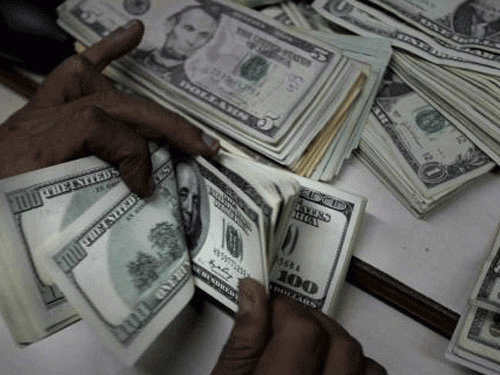By Staff Reporter
ISLAMABAD: Pakistan’s external borrowing jumped 58 percent in the first quarter of the current fiscal year 2023-24, as the country sought to bolster its foreign exchange reserves and meet its debt obligations amid a challenging economic situation.
The country borrowed $3.527 billion from various financing sources in the July-September period, up from $2.234 billion in the same period of the previous fiscal year, data from the Economic Affairs Division (EAD) showed on Friday.
The borrowing included $2 billion received from Saudi Arabia as a time deposit in July, which helped boost the country’s reserves. However, the EAD data did not reflect the inflows of $1.2 billion from the International Monetary Fund (IMF) and $1 billion from the United Arab Emirates (UAE), which were also received in July as part of the $3 billion Stand-By Arrangement (SBA) and the oil facility agreement, respectively. If these inflows are added, the total borrowing would reach $5.727 billion in the first quarter.
The government has budgeted $17.619 billion from multiple financing sources for the fiscal year 2023-24, including $17.384 billion in loans and $234.6 million in grants. The borrowing target is lower than the $22.817 billion budgeted for the previous fiscal year, when the country actually borrowed $10.844 billion, excluding the rollover of friendly countries’ deposits and refinancing of Chinese loans.
The government has also budgeted $2.4 billion from the IMF, $4.5 billion from foreign commercial banks, and $1.5 billion from the issuance of bonds for the current fiscal year.
However, no money was received from these sources in the first quarter. The IMF program is pending a review of economic performance and reforms, and the bond issuance is delayed due to unfavorable market conditions.
The country received $490.48 million from multilateral lenders and $324.05 million from bilateral donors in the first quarter, mainly for project financing and budgetary support. China was the largest bilateral lender, disbursing $508.34 million for a defense project funded by China National Aero-technology Import and Export Corporation (CATIC). The Asian Development Bank (ADB) disbursed $61.75 million, while the World Bank’s International Development Association (IDA) disbursed $240.93 million.
The country also received $204.51 million under the head of “Naya Pakistan Certificate”, a diaspora bond scheme launched by the government to attract foreign investment from overseas Pakistanis. The scheme offers attractive returns ranging from 5.5 percent to 7 percent per annum for maturities of three months to five years.
Pakistan’s external borrowing reflects its high dependence on foreign inflows to finance its current account deficit, which widened to $1.47 billion in September from $632 million in August, due to a surge in imports of machinery, petroleum products, and food items. The country’s external debt and liabilities stood at $116.3 billion as of June 2021, equivalent to 41.6 percent of its gross domestic product (GDP).
The government faces significant challenges in managing its external debt servicing, which is projected to reach $10.4 billion in the current fiscal year, including $3.7 billion due to multilateral and bilateral creditors, $3.1 billion due to foreign commercial banks, and $2.5 billion due to bondholders. The government has been seeking debt relief and rescheduling from various creditors under the G20’s Debt Service Suspension Initiative (DSSI) and the Common Framework for Debt Treatments beyond the DSSI.
The government has also been pursuing structural reforms and fiscal consolidation measures to improve its macroeconomic stability and growth prospects, as part of its IMF program and other development partners’ assistance. However, these targets may be affected by the uncertainty caused by the economic showdown, rising inflation, political instability, and security risks.
The country received $490.48 million from multilateral donors and $324.05 million from bilateral donors during July-September 2023-24. Non-project aid totaled $2.653 billion, including $2.253 billion for budgetary support. Project aid totaled $873.97 million.
China disbursed $508.34 million under the guaranteed head for the JF-17 B project, which is funded by the China National Aero-technology Import and Export Corporation (CATIC). China further disbursed $0.35 million in July-September against the government-budgeted $18.54 million for the current fiscal year.
The Asian Development Bank (ADB) disbursed $61.75 million during the period under review, compared to the budgeted $2.086 billion for the 2023-24 fiscal year.
Saudi Arabia disbursed $300 million against the budgeted $600 million under the oil facility head during July-September 2023-24. The United States disbursed $13.98 million in the first three months, against the budgeted $21.60 million for the fiscal year. Korea disbursed $4.85 million and France disbursed $1.28 million during the current fiscal year.
The International Development Association (IDA) disbursed $240.93 million in July-September against the budgeted $1.489 billion for the current fiscal year. The International Bank for Reconstruction and Development (IBRD) disbursed $58.45 million against the budgeted $840.36 million. The Islamic Development Bank (IsDB) (short-term) disbursed $100 million in July-September against the budgeted $500 million for the current fiscal year. The Asian Infrastructure Investment Bank (AIIB) disbursed $22.96 million, while the International Fund for Agricultural Development (IFAD) disbursed $6.38 million against the budgeted $42.68 million for the current fiscal year.
Copyright © 2021 Independent Pakistan | All rights reserved




